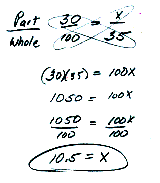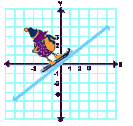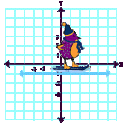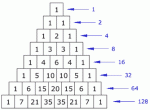In 2010 I had the opportunity to travel to Moscow, Russia where the currency is the Russian Ruble. 29.93 Russian Rubles is equivalent to 1 US Dollar; therefore, every time I made a purchase, I converted the Russian Rubles to US Dollars to understand the real value of my purchases. For example, if a large bag of potato chips had a price tag of $89.73, I used my knowledge of proportions to convert the price to US Dollars. The example below illustrates how I used proportional reasoning to convert the prices.
Example #1
If 1 US Dollar = $29.93 Russian Rubles, what is the dollar value of a $89.73 bag of potato chips?
Step 1
Create a ratio, or part to part relationship.
$1 US Dollar/$29.93 Russian Rubles
The ratio above means that for every $1 US Dollar, there are $29.93 Russian Rubles.
Step 2
Create another ratio, or part to part relationship, that includes the missing value.
C/$89.73 Russian Rubles
The ratio above asks that question: how many US Dollars are there for every $89.73 Russian Rubles?
Step 3
Make the two ratios equivalent so they become a proportion.
$1 US Dollar/$29.93 Russian Rubles = C/$89.73 Russian Rubles
The proportion above asks the question: if $1 US Dollar represents $29.93 Russian Rubles, how many US Dollars represent $89.73 Russian Rubles?
Step 4
Cross multiply on both sides of the proportion. For example, $29.93 Russian Rubles times C, and $1 US Dollar times $89.73 Russian Rubles. The cross multiplication produces the following equation:
$29.93(C) = $89.73
Step 5
To solve the equation, isolate the variable, C, by performing the inverse, or opposite, operation. The inverse of multiplying by $29.93 is dividing by $29.93.
$29.93(C)/$29.93 = 1(C)
Step 6
Since we divided by $29.93 on the left side of the equation, we must also divide by $29.93 on the right side of the equation, because equations must maintain their balance.
$89.73/$29.93 = $2.99
Final Answer
1C = $2.99
The final answer means that $89.73 Russian Rubles is equivalent to 2.99 US Dollars. Thus, a large bag of potato chips that are $89.73 Russian Rubles have the same value as 2.99 US Dollars.

Example #2
The school’s planning committee has decided to make and purchase Country Time Lemonade for the student’s Valentines Day party. One 82.5 oz canister of Country Time serves 136 people. How many canisters of lemonade are needed to serve approximately 300 people/students?
Step 1
Create a ratio, or part to part relationship.
One Canister (82.5 oz)/136 Students (Servings)
The ratio above means that for every one canister of 82.5 oz lemonade, 136 students can be served.
Step 2
Create another ratio, or part to part relationship, that includes the missing value.
C/300 Students
The ratio above asks that question: how many canisters of lemonade are needed to serve 300 students?
Step 3
Make the two ratios equivalent so they become a proportion.
1 Canister/136 Students = C/300 Students
The proportion above asks the question: if 1 Canister of lemonade serves 136 students, how many canisters are needed to serve 300 students?
Step 4
Cross multiply on both sides of the proportion. For example, 136 Servings times C, and 1 Canister times 300 students. The cross multiplication produces the following equation:
136(C) = 300
Step 5
To solve the equation, isolate the variable, C, by performing the inverse, or opposite, operation. The inverse of multiplying by 136 is dividing by 136.
136(C)/136 = 1(C)
Step 6
Since we divided by 136 on the left side of the equation, we must also divide by 136 on the right side of the equation, because equations must maintain their balance.
300/136 = 2.20
Final Answer
1C = 2.2 of a Canister, or 3 Whole Canisters
The final answer suggests that 3 Canisters (82.5 oz) of Country Time Lemonade are needed to serve 300 students. Since the final answer, 2.20, has a remainder, it means that 2 Canisters are not enough; therefore, an additional Canister is need.


























